After spending 2020/21 on loan at Brest, and really only starting to enter the first-team picture in the latter stage of the season, Rennes academy product Lilian Brassier (184cm/6’0”, 78kg/172lbs) joined Les Pirates on a permanent deal for just €2m last summer. The 22-year-old’s performances this season have made this deal look like incredibly good business from the Brittany-based club, as for me, Brassier has been one of the biggest standouts among the young centre-backs in Ligue 1 this term.
Brassier was one of several players who arrived at Stade Francis Le Blé last summer that have gone on to be pretty important within new manager Michel Der Zakarian’s first-team setup this term. Romain Del Castillo joined the club from Rennes along with Brassier, while the ex-Rennes duo were joined at their new club by fellow fresh arrivals Marco Bizot, who made his move from Eredivisie side AZ Alkmaar and Lucien Agoumé, who joined Brest on loan from Serie A side Inter last summer.
Despite all of this solid transfer business, Der Zakarian has recently shared public criticism of Brest, declaring that: “the club lacks ambition”, in his view. The 59-year-old used the club’s January sale of star man Romain Faivre to Ligue 1 rivals Lyon for a reported initial fee of €15m as an example of this, while one could also possibly use Brest’s summer sale of left-back Romain Perraud to EPL side Southampton for around €13m as another example of this. However, it may also be worth noting that both transfer fees received may represent decent business from Brest, as both fees eclipse what the club has spent on incoming transfers this term and under new boss Der Zakarian, Les Pirates currently sit in 13th place on the table, well clear of the drop zone with Brest finishing in 17th last season.
From all of this, though, perhaps we can gather that Brest are happy to sell players for a reasonable price regardless of their significance within Les Pirates’ squad, which could make a name like Brassier one to keep a close eye on should his development continue to progress as it has thus far at Stade Francis Le Blé — something I’d be quietly confident of under the tutelage of Der Zakarian, who’s one of Ligue 1’s most unique and, for me, most impressive managers. This tactical analysis and scout report aims to provide some in-depth analysis of Brassier, his role within this Brest squad and their tactics, as well as his quality to give readers a better idea of what kind of player he is and how much quality he has.
What’s Brassier’s role at Brest?
To kick off this scout report, I’ll aim to provide some initial insight on Brassier’s role within Brest’s strategy and tactics. This information could be important to keep in mind as we progress deeper into this analysis, as Brassier’s tendencies and performances this season must be looked at through the context of his role within Der Zakarian’s system. As mentioned above, the 22-year-old is a centre-back.
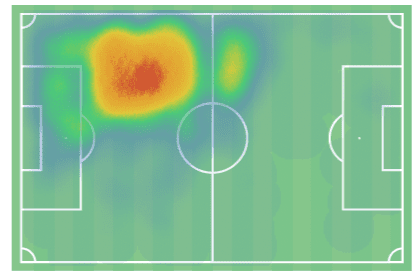
As Brassier’s heatmap for the 2021/22 campaign, shown in figure 1, indicates, the Brest man typically occupies the left centre-back position — probably not a major surprise given that he is a left-footed centre-back. While clearly left-footed, Brassier isn’t completely averse to using his weaker right foot and is functional on his weaker side. Brest have typically lined up in a 4-2-3-1 shape under Der Zakarian this season, with the club occasionally switching to a three-centre-back system but generally opting to go with two centre-backs, meaning Brassier is typically paired with one central defensive partner.
Brest are one of the least possession-oriented sides in Ligue 1, keeping an average of 43.3% possession this term, which trails only Metz and Reims. It’s important to keep this in mind when judging the statistics and data that we’ll come to later in this analysis. As obvious as it may seem, Brassier’s role is primarily a defensive one. His quality in stopping opposition attacks cleanly and efficiently is highly valued in his team. However, the centre-back is also, nevertheless, a key man in possession for Der Zakarian’s side, often tasked with launching his side’s attacks and progressing them into more threatening areas of the pitch.
A lot is demanded of the 22-year-old within this tactical setup, as he carries plenty of diverse responsibilities, but he has largely risen to the occasion in 2021/22 and become an important cog in this Brest side by consistently performing his role to a high standard.
On-the-ball
Moving on into the next section of this scout report, I plan to highlight some of the key information concerning Brassier’s ability and tendencies on the ball. Firstly, per Statsbomb via FBRef, the centre-back plays 3.21 progressive passes per 90, ranking him in the 69th percentile among Ligue 1 centre-backs for 2021/22, which I’d say is fairly positive considering his team’s relatively low level of possession.
One of the major ways in which Brassier typically progresses his team upfield is via his long passing, with the 22-year-old having completed 11.35 long passes per 90 this season, ranking him in the 80th percentile for this particular metric among his league peers. It’s common to see the Brest man launching the ball forward into the channels or towards the centre-forward to set his team up to attack from a more advanced position.
It’s also common to see Brassier using his role as an orchestrator from deep to spread the ball around the pitch and create opportunities for his wide attacking teammates to drive at the opposition defence from the wing after a 1v1 opportunity is created by the initial switch pass out to the wing. Per Statsbomb via FBRef, a switch is defined as any pass that “travels more than 40 yards of the width of the pitch”, and Brassier ranks in the 73rd percentile for these among Ligue 1 centre-backs in 2021/22, having played 2.05 per 90 so far this term.
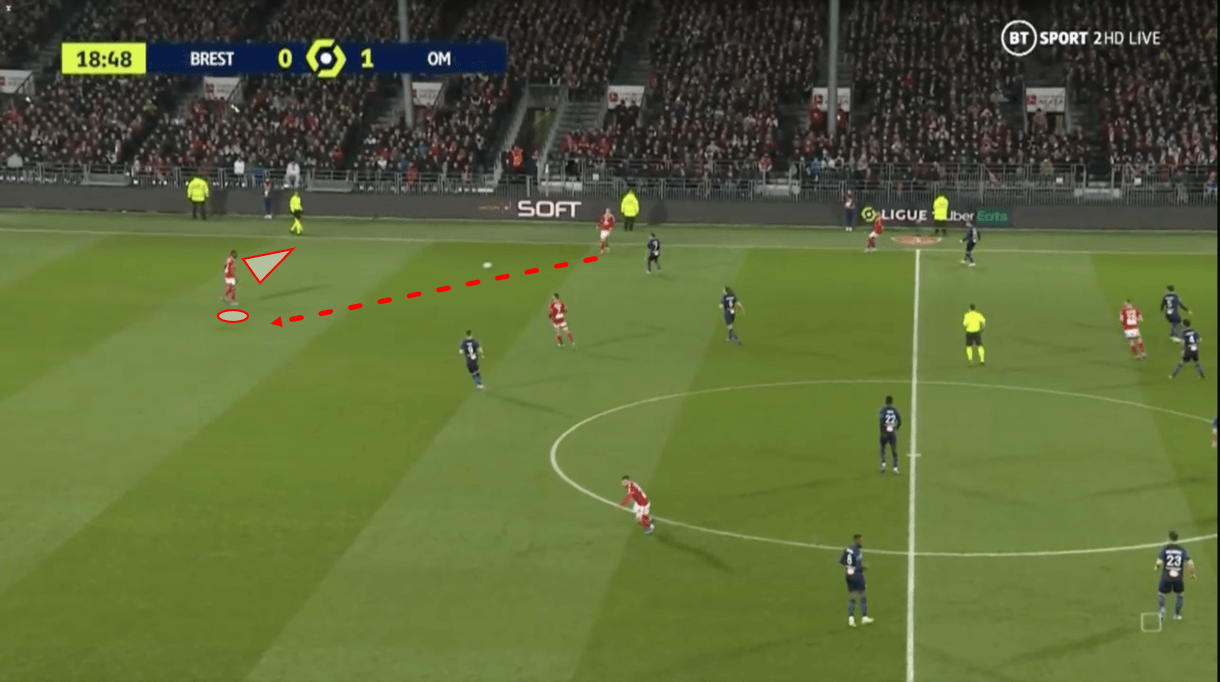
Figures 2-4 highlight an example of Brassier picking up the ball deep and driving forward to a point before progressing his team into a more dangerous position via the subsequent switch pass. In figure 2, we see the centre-back receiving the ball from his left-back teammate. After the ball leaves his teammate’s boot and begins travelling towards him, Brassier wisely takes the opportunity to scan while the ball is in motion. By scanning here, Brassier gives himself an idea of where his teammates are situated further upfield while he also gives himself an idea of where the opposition are placed at this moment and from where he may need to anticipate incoming pressure.
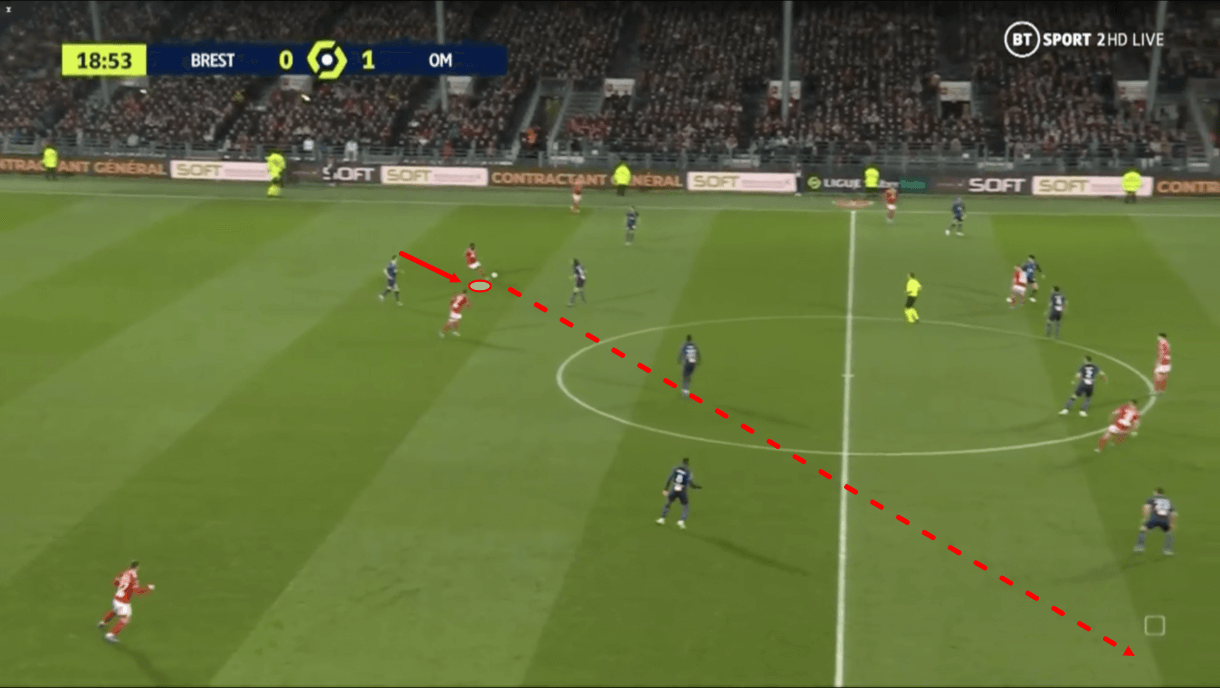
Progressing into figure 3, we see how Brassier has driven forward with the ball, attracting some but not a tonne of pressure onto himself, evading the pressure from the opposition centre-forward, attracting the right central midfielder in, but ultimately opting to release before the opposition got too near.
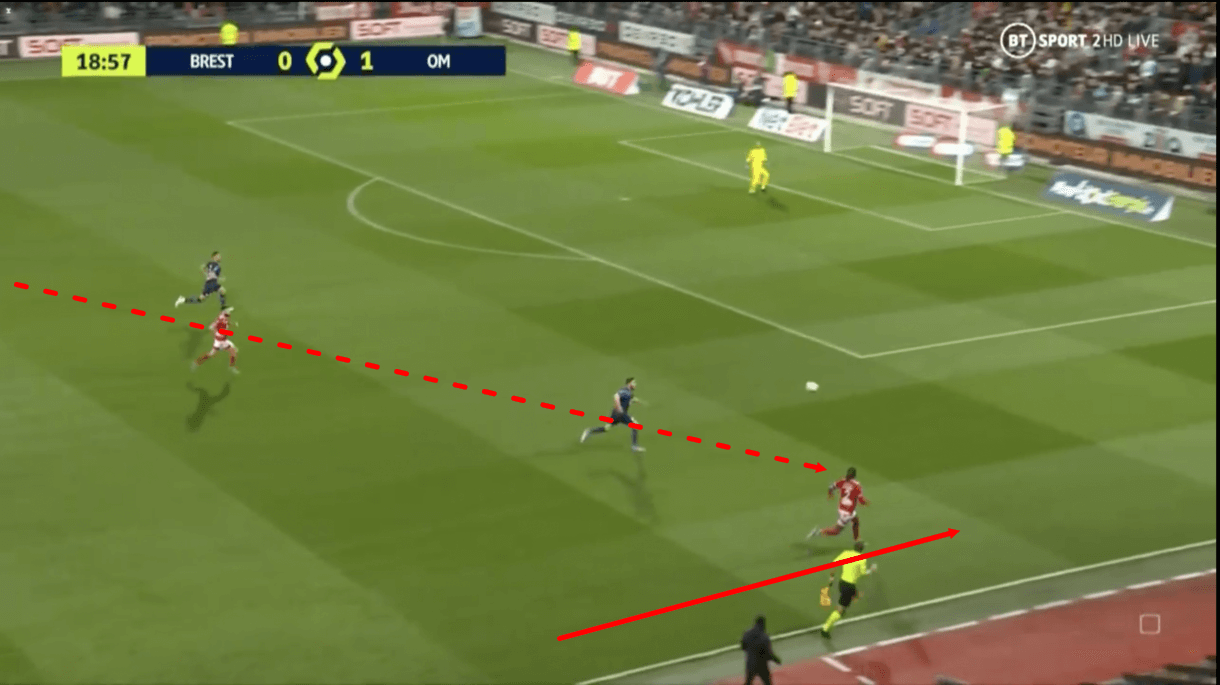
As we move on into figure 4, we see how the centre-back drove the ball across the pitch and into the path of his teammate bursting forward into space on the right-wing. This is an example of how Brassier is capable of setting his team’s wide attackers up in dangerous 1v1s with the opposition full-back in far more threatening positions than the one in which he picked up the ball, where necessary. This is a very useful skill for his side, as Brassier can create excellent attacking opportunities out of very little, as was the case here, which has the potential to be very beneficial for Brest. On this occasion, the ball drops into such a great position that the receiver can drive in behind the opposition’s backline on meeting the pass to attack the box.
This passage of play also highlights Brassier’s excellent vision, quality of scanning, quick decision-making and comfortability with driving his team upfield on the ball at least a few steps with his carry before passing. The latter is another important technical element of Brassier’s game worth noting. He doesn’t often engage in senseless carries aiming to beat players when there isn’t a great chance of success, but he possesses enough technical quality to be able to carry the ball out of pressure or upfield into a better position when necessary. His quality decision-making helps him to ensure he doesn’t do this senselessly and he maintains his very solid error rate, which all-around makes him quite a reliable centre-back on the ball.
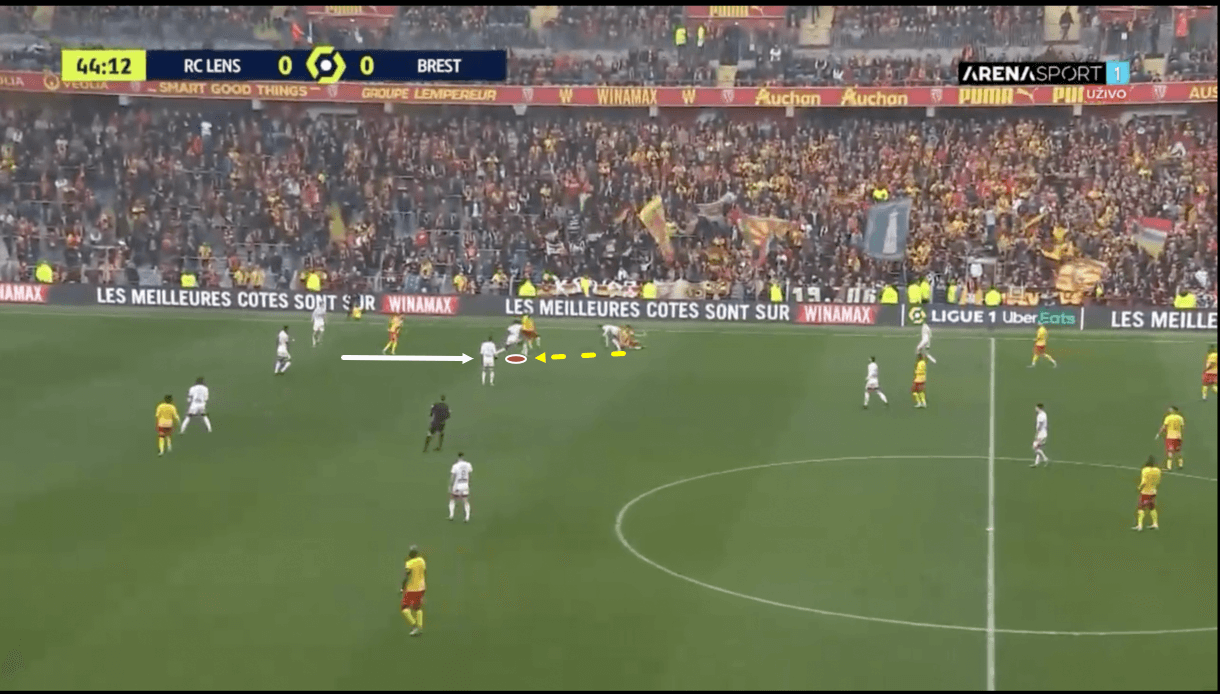
In figure 5, we see an early glimpse of Brassier’s off-the-ball quality, as he uses his strength and frame to shoulder an opposition attacker off the ball as they attempt to receive this pass. The defender, occupying quite an advanced position after pushing out of the backline, demonstrates comfortability with using his body and strength in the 50/50 to dispossess the attacker and come out of this duel with the ball.
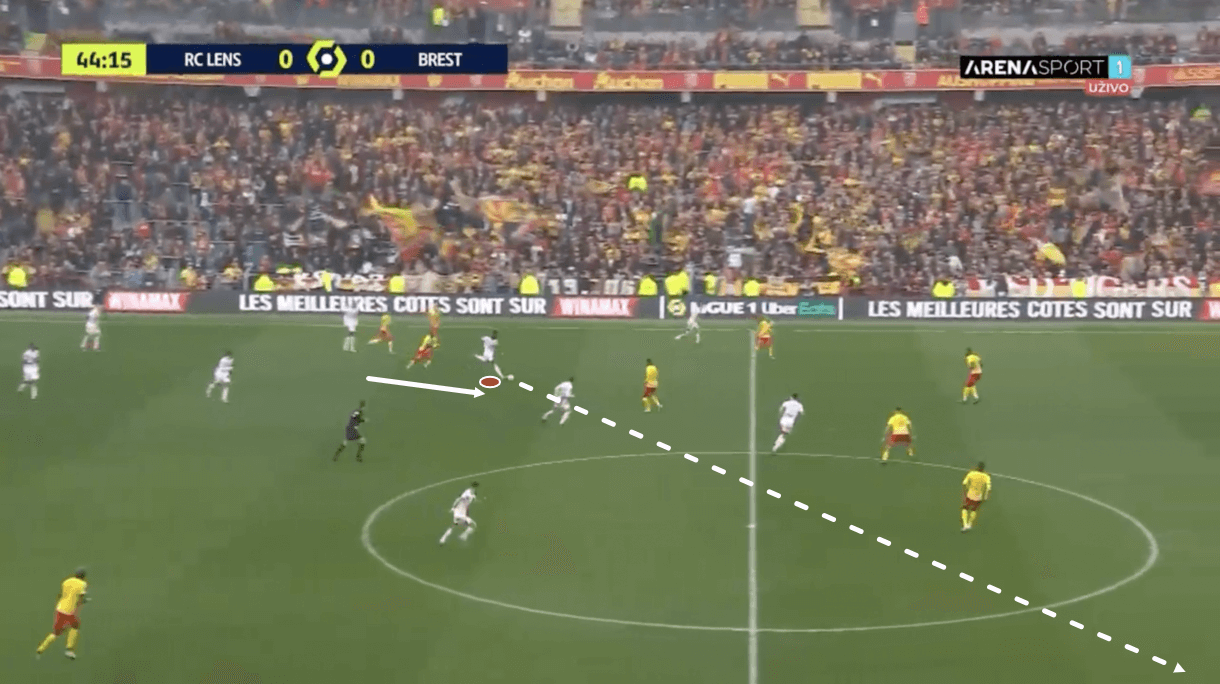
The reason I include this passage of play here isn’t so much to look at Brassier’s defensive ability, however — that comes later — rather, it’s to highlight how well the centre-back does at getting away from the opposition players surrounding him in figure 5 after he regained possession for his team before progressing with the ball into the more valuable position we see him occupying in figure 6.
After winning the 50/50 in figure 5, Brassier spun around, demonstrating his deceptively good agility, which is very useful in helping him with his carries and to get out of trouble when necessary. This can be a really useful tool for a centre-back to have as it can lead to progression as we see in figures 5-6 but again, as previously mentioned, he’s currently good at not trying to do too much and just using this ability when necessary, while keeping things relatively simple the majority of the time, which I like.
Similar to the previous passage of play, after evading the pressure here, Brassier created an opportunity to switch the play to the right wing via a long pass from his left foot, again highlighting his tendency to switch play and to progress the ball via long passes.
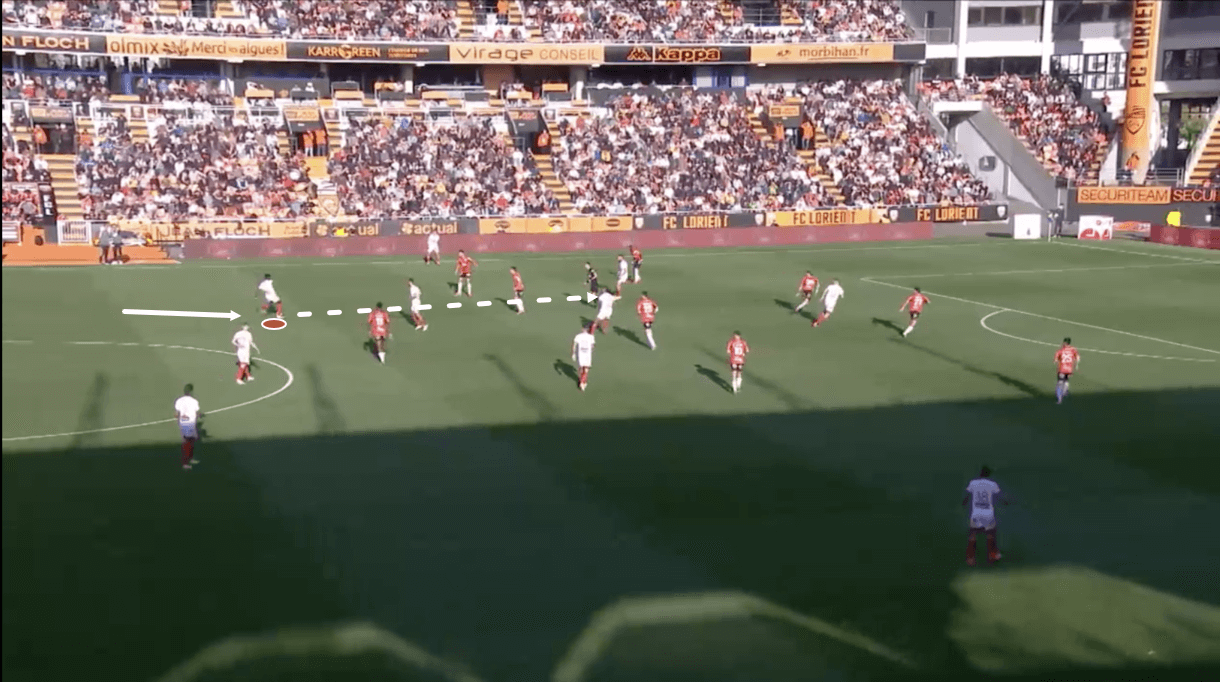
However, Brassier isn’t just a long passer, he’s also capable of breaking lines and progressing his team upfield via ground passes. We see an example of one such occasion here in figure 7. Just before this image, the centre-back received the ball in his left centre-back position before carrying it a few steps forward. It’s worth noting that when Brassier carries the ball forward, it’s common to see him doing so with his head up, confidently looking around and surveying the pitch around him to assess his options and decide on his next move. This, along with his tendency to take a really good, positive first touch, is another subtle but important element of the Frenchman’s game on the ball. On this occasion, he opted to drive the ball into the feet of his teammate in the left half-space, splitting the two opposition defenders in front of him in figure 7 in the process.
This pass was accurate and the decision was quite good, as it showed Brassier taking advantage of an opportunity to break the opposition’s midfield line and send the ball to a teammate in some space in quite a dangerous area. However, the pass was a little bit too strong and the receiver’s first touch wasn’t good enough to compensate for that, leading to a turnover.
Brassier can work on measuring these kinds of passes better to become an even bigger asset on the ball, as his vision is excellent. If he were able to work on playing passes like this one with greater care, striking a better balance between power and precision while still retaining this level of accuracy, this would take the centre-back’s game up another level.
Aggressive defending
I’m splitting Brassier’s defensive qualities/tendencies into two separate sections, the first of which will focus on the centre-back’s aggressive defending. As the title of the section suggests, Brassier is comfortable defending on the front foot and engaging opposition attackers in rather advanced areas of the pitch, leaving the backline to force engagements in more advanced positions as opposed to defending more passively.
The Brest defender applies a high amount of pressure in deeper areas, ranking in the 79th percentile for pressures in the defensive third and ranking in the 75th percentile for pressures in the middle third. Furthermore, Brassier ranks in the 74th percentile for successful pressures. All of this data comes from Statsbomb via FBRef and compares Brassier with Ligue 1’s centre-backs for the 2021/22 campaign. This information paints the picture of someone who’s fairly aggressive in defending in his own half and this is definitely true of Brassier, with figure 5 in the previous section providing just one of many examples of the 22-year-old jumping out of the backline to engage an attacker in a more advanced area — with success.
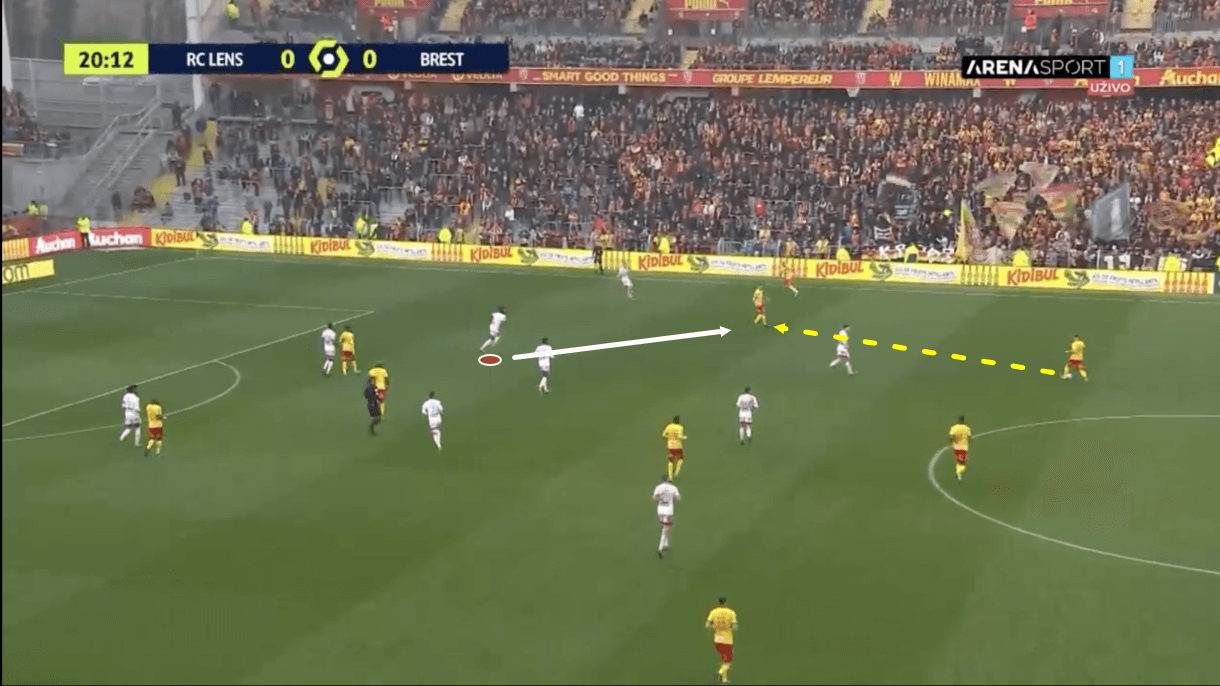
We see another example from this same game versus Lens in figures 8-9. Starting from figure 8, we see the opposition aiming to progress the ball into Brest’s third of the pitch. Spotting the danger and backing his physical ability to get to the intended receiver in time to stop progression from this move, Brassier jumps out of the backline to aggressively engage the attacker.
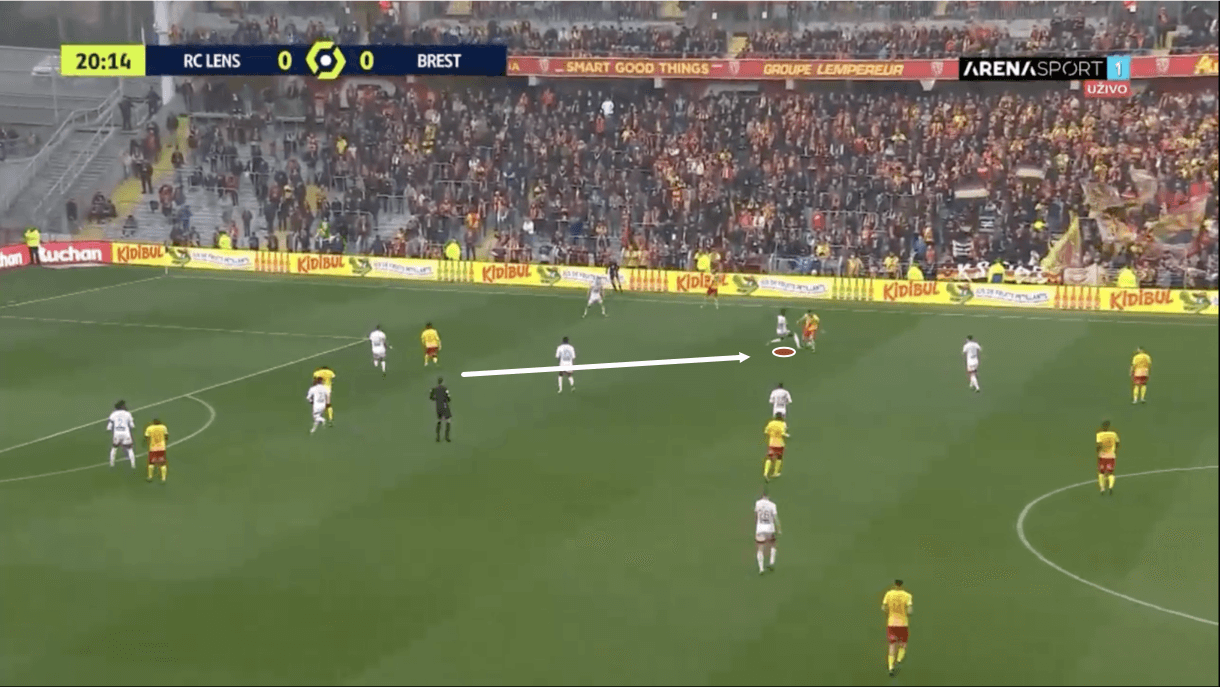
As the pass arrives at the receiver’s feet and this player begins to turn, he’s met by the aggressive Brassier who doesn’t allow the Lens attacker to take a step forward. Immediately on turning, the attacker is dispossessed by Brassier who gets a foot in and demonstrates excellent technical defensive ability to regain possession for his side in a crucial moment.
Had the defender failed to win the ball here, it could’ve created a very threatening situation for Brest’s defence, as the attacker could’ve gone past Brassier and driven forward to potentially overload the opposition’s backline. However, that wasn’t to be as Brassier’s technical tackling quality combined with his pace and anticipation to stop this attack. These qualities are why his team trusts him to defend so aggressively with regularity and he performs this aggressive defensive role very well.
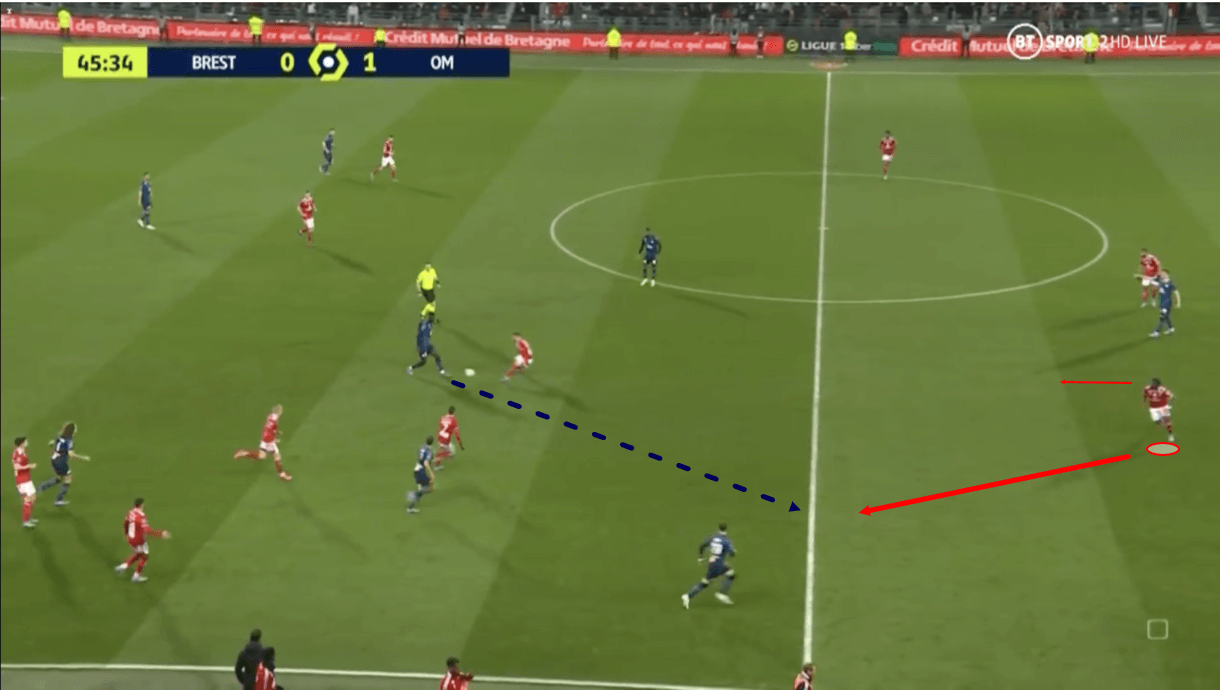
We’ve also seen examples of Brassier’s pace combining with elite anticipation when we look at some of his interceptions from this season, with figures 10-11 showing an example of this. Similar to the previous passage of play, here in figure 10 we see a pass being played with the opposition looking to progress upfield — this time into Brest’s half of the pitch on the counter-attack. Brassier is alert to this again as the ball leaves the passer’s foot and quickly springs into action to try and deal with the issue.
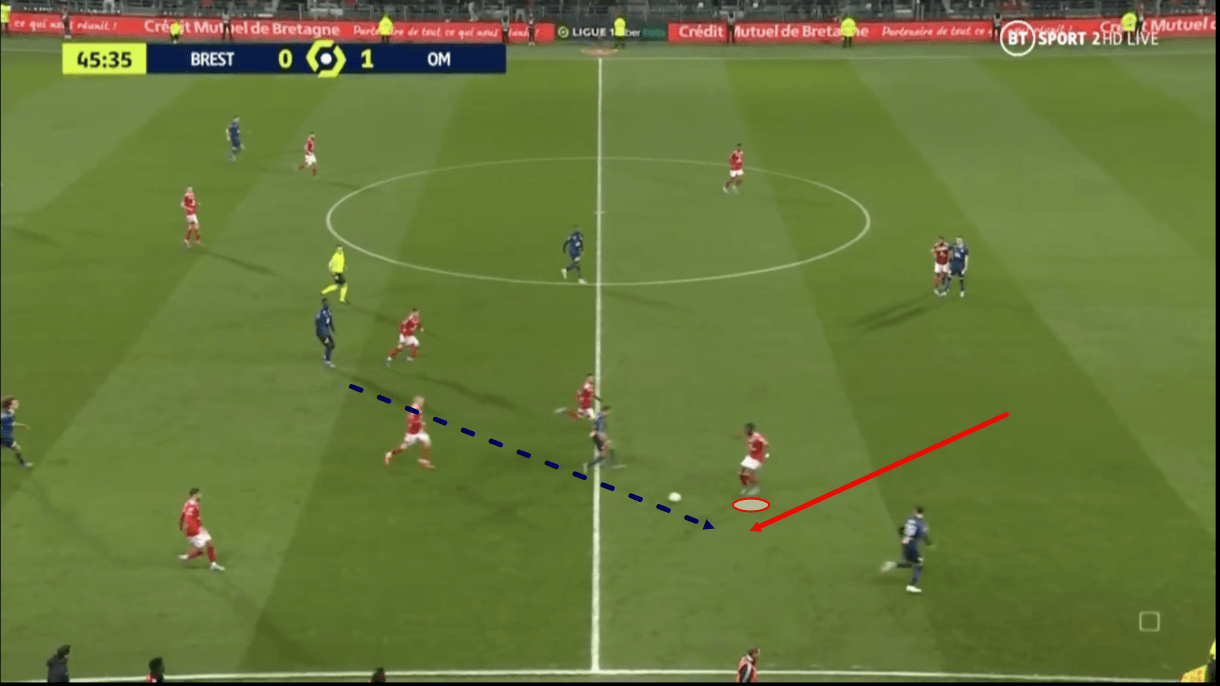
The pass never reaches its intended recipient on this occasion, as the Brest defender’s anticipation and pace prove good enough to put him in the right place at the right time to cut out this through pass, ending the opposition’s counter-attack at around the halfway line and creating an opportunity for his team to sustain pressure on the opposition’s defence by springing an attack of their own once more.
To summarise, pace, a good level of anticipation and technical ability are all evident in Brassier’s game when required to defend aggressively in more advanced areas. These qualities, along with good jumping height, are also evident when Brassier is required to engage attackers in aerial duels in advanced areas and he tends to perform quite well in these situations too, as he’s happy to play aggressively and impose himself on the opposition.
Recovery
For the final section of this scout report, I’m going to focus on Brassier’s ability to provide defensive cover behind his team’s backline. Again, his pace and anticipation are important here, as is technical ability. However, covering behind the backline as opposed to jumping forward from the backline is different and thus tests different areas of these particular attributes, which we’ll highlight in this section of analysis.
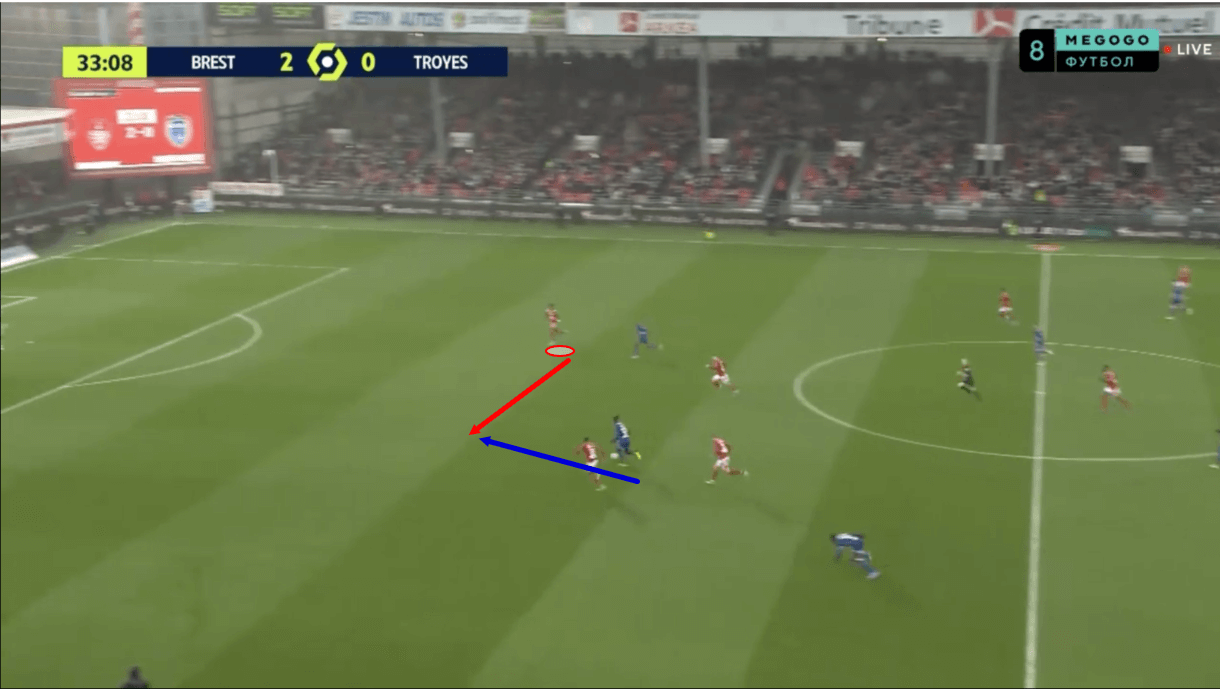
There are lots of examples from this season of Brassier running back to recover and/or defend space as the opposition aim to exploit it behind his team’s defensive line. The necessary recovery pace and anticipation levels, which Brassier possesses, have proven very useful for Brest when this space behind their backline has been targeted. We see just one example of these skills in action in figures 12-13.
Here in figure 12, we see the opposition attacking space behind Brest’s backline down the left side (Brest’s right side) on the counter, with only left centre-back Brassier, on the opposite side, left behind the ball. There have been several examples of the 22-year-old ending up in this kind of situation this season where he needs to cover across the backline as his team gets attacked, such as in this example. It’s important that the defender gets his timing spot on in such situations, as going too early would leave the attacker he’s already marking open but going too late would allow the ball-carrier to get past.
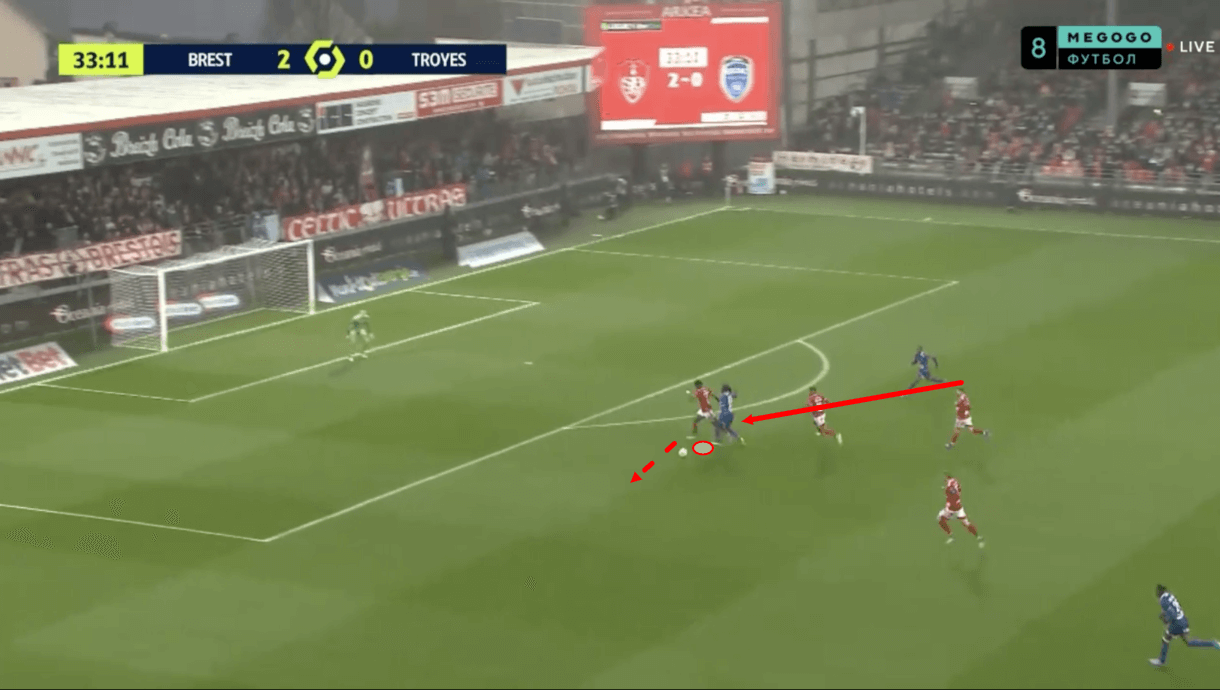
Fortunately for Brest, Brassier’s anticipation, timing and physical qualities are very good and he has the quality to succeed in these scenarios, as was the case in figure 13. Here, the centre-back calmly bided his time, waiting for the right moment to fully commit to jumping from one attacker to the other, leading to the image we see above, with Brassier coolly stepping across and stopping the ball-carrier in his tracks, knocking the ball out of his control.
The ball-carrier likely failed to anticipate Brassier’s pace would be good enough to pull this off but the defender demonstrated elite ability in this situation to cut across the attacker and end this attack at a crucial moment for his side, showing how the 22-year-old Brest man can be a very clutch player for his team in moments of desperation. Brassier’s ability to consistently remain calm in situations like this despite the high pressure only adds to his quality and reliability as a centre-back.
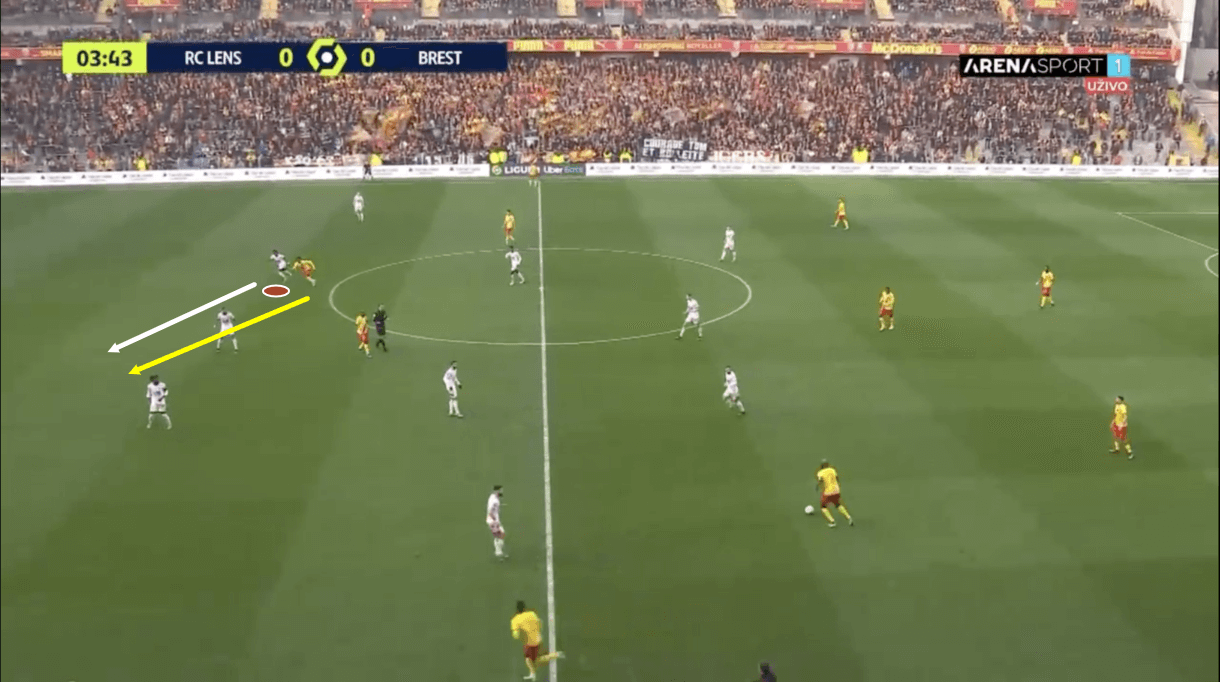
The final passage of play I’ll analyse in this piece will be shown in figures 14-16. Again, this highlights the combination of anticipation, physicality and technical quality that has made Brassier a really useful asset for Der Zakarian’s men in 2021/22. Here in figure 14, we pick up the play with Brassier’s man beginning to make his run across the backline, aiming to make himself an option for the deep playmaker in possession in the middle third here.
Brassier demonstrates excellent awareness of the opposition’s intent here, as he spots the danger immediately and gives the runner no space to run into by following his run, as the image above depicts.
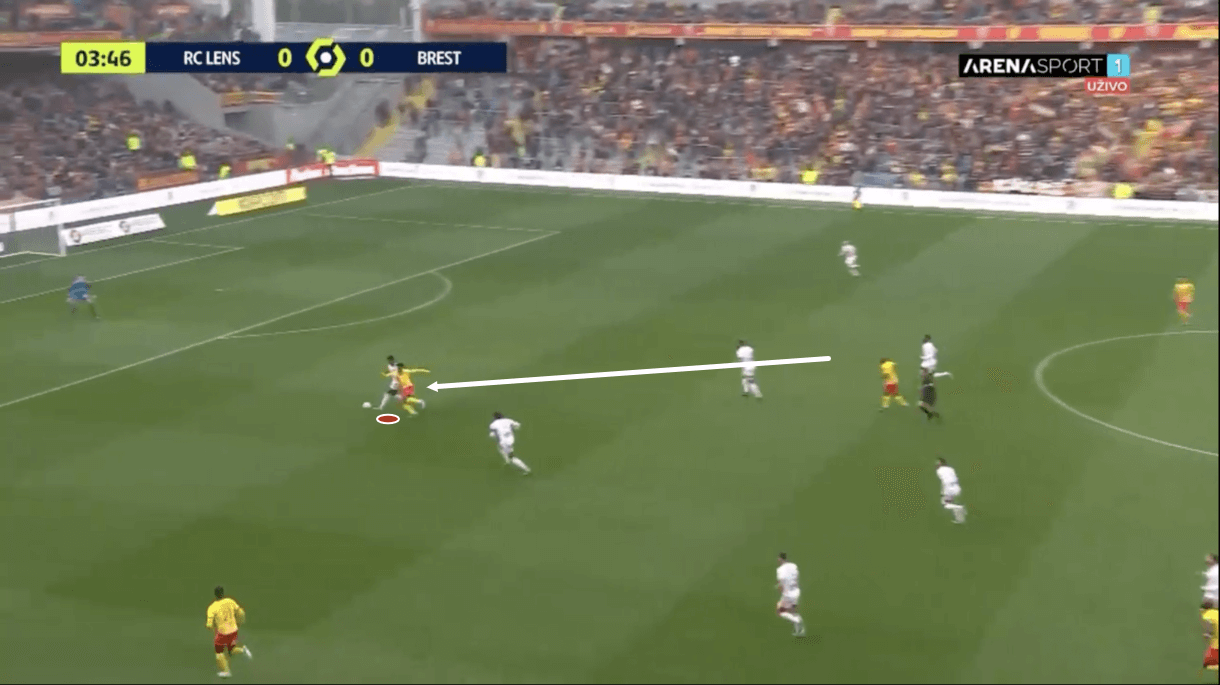
The pass was played into this runner’s path but Brassier was in position to deal with the danger and prevent this attacker from running at goal. The defender stubbornly placed himself goal-side of the attacker and got really tight to him to impose himself on the player physically too, limiting how he could turn and where he could move. This forced the attacker to go on the outside, further away from goal, and Brassier forced the player into a heavy touch via this defensive movement and positioning, creating an opening for himself to burst ahead and regain possession for his side, which he does.
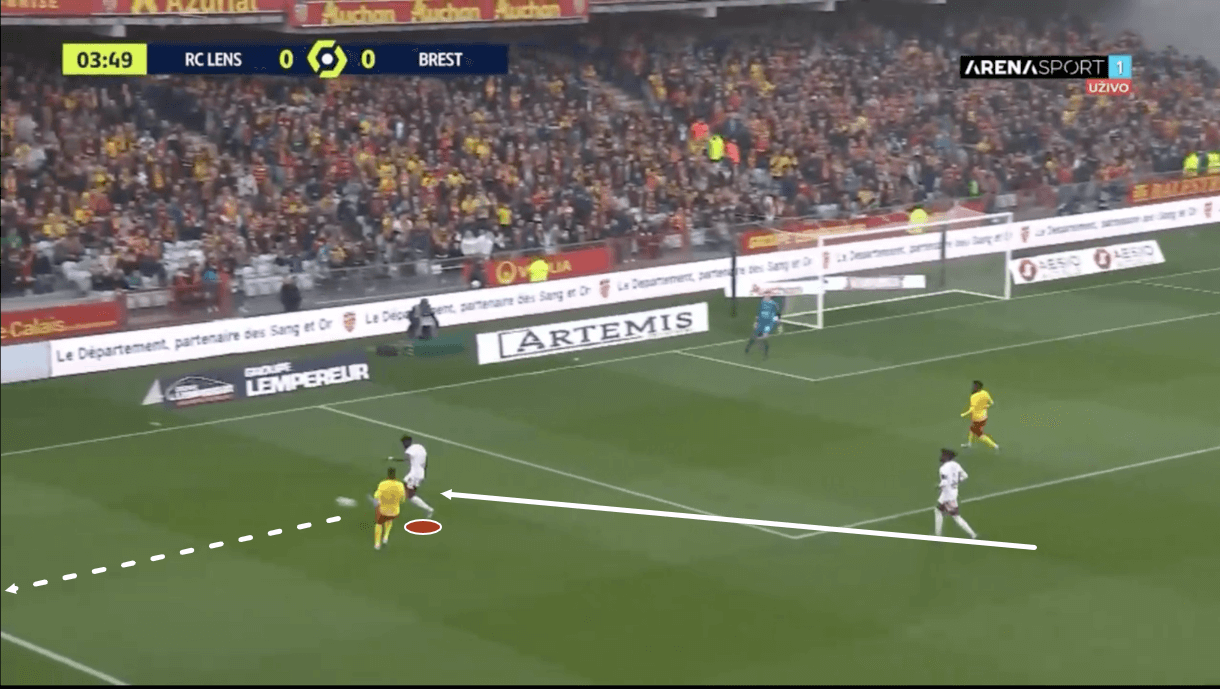
Lastly, in figure 16, we see the end result of this defending, as Brassier ends up back in control of the ball in his own third, though under some intense pressure from another opposition player. Under pressure, Brassier takes the safe and perhaps sensible option of conceding the throw-in, allowing his teammates to get back and regroup defensively while avoiding a defensive calamity by trying to turn away from the defender or play his way out of the danger. I like the risk assessment from Brassier here and feel this was a good decision on this occasion from the defender, which highlights the quality we mentioned earlier, that the 22-year-old is good at not overdoing it on the ball, even though he possesses decent quality on the ball.
Conclusion
To conclude this tactical analysis piece, I really like Brassier and feel that among Ligue 1’s U23 centre-backs, he’s one of the standouts that should be watched closely, particularly as he plays for a club that has demonstrated an openness to sell for the right price, as was recently criticised by their manager, Der Zakarian.
I think Brassier could be a very interesting option for a club like Nice to consider, and feel at least in possession, the Frenchman could represent a potential replacement for Dante in the future, with the Brazilian, though still brilliant, undoubtedly in the latter stages of his career. Yes, Brassier defends very differently from Dante and he doesn’t have the same quality on the ball, but I think he could develop into a similar asset on the ball while defending in a different yet effective way. I certainly view the 22-year-old’s future as being at a slightly higher level than Brest. I feel he could play for one of Ligue 1’s more ambitious teams who aim to compete in Europe regularly, for example.





Comments